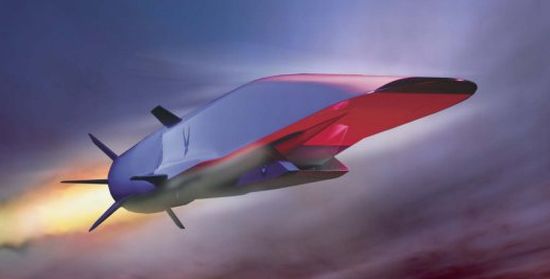
Hypersonic jet X-51A WaveRider has been tested by US military in a bid to reach Mach 6 (4,300 mph; 6,900 km/h) above the Pacific Ocean.
At that speed it could travel from London to New York in about an hour. Results from the test flight have not yet been released.
The Pentagon and NASA hope to use the project to develop faster missiles.
During a test in June 2011, WaveRider travelled at Mach 5, but failed to reach the target speed.
It is one of several projects currently under way to create a hypersonic aircraft.
The research could also be used to build a commercial plane, able to reach much higher speeds than today’s jets, after Concorde was decommissioned in 2003.

The military intended to use a B-52 bomber to lift the wingless unmanned jet from US Edwards Air Force Base in California to 50,000 feet (15,250m).
The craft was then to be dropped and after a free fall of about four seconds, its engine is supposed to ignite.
X-51A WaveRider was then expected to climb to 70,000 ft (21,300 m) and eventually reach Mach 6.
The Mach number is the ratio of the speed of an object to the speed of sound. Mach 1 is the speed of sound – approximately 768 mph, depending on various factors including temperature and altitude.
So Mach 6 is six times the speed of sound. Concorde’s cruising speed was Mach 2 – it flew from London to New York in just over three hours.
The WaveRider test flight was expected to last for about five minutes before the craft falls into the Pacific.
The test is essentially a repeat of last summer’s attempt, when the hypersonic aircraft reached Mach 5, but the engine failed to attain full power.
Military officials said the results would be available later on Wednesday.
European aerospace and defense giant EADS believes that hypersonic passenger flights are likely to appear in the near future. In 2011, EADS presented its own concept of a commercial high-speed aircraft designed to fly at Mach 4.
“The business community who wanted to be in New York in three hours made Concorde highly viable, and now there’s interest on both sides of the Atlantic to jump a generation and go from supersonic flight to hypersonic flight,” said EADS’ vice-president of business development, Peter Robbie.
“Such an aircraft will be very expensive, of course, because of the enormous amounts of energy that is required to get to such speeds.
“But the idea of going from Tokyo to Paris in two-and-a-half hours is very attractive for the business and political community – and I think that by about 2050, there may be a viable commercial aircraft.”
In August 2011, US military scientists attempted to get another unmanned hypersonic experimental aircraft to reach Mach 20 – 20 times the speed of sound.
However, they lost contact with the Falcon Hypersonic Test Vehicle 2 (HTV-2) after it had separated from its rocket.